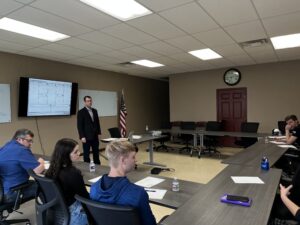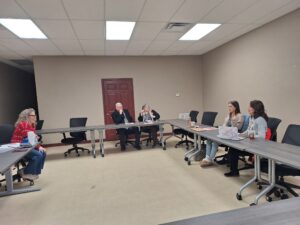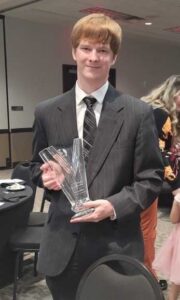
Entrepreneurship and Adaptability: Bruce Jones and Forty Years of Technology
September 1, 2023 by Jessika Leatherbury
By: Sunnie Dawn Baker
 It was the winter of 1986 and Bruce Jones was sitting in a cold dark room, wearing a heavy military coat. The heat was off, and the only light came from the computer monitor in front of him. He had started his business, Workable Programs and Systems, Inc. (WPS) three years prior. While business was going well, he also knew that as an entrepreneur trying to build his business, he had to save every penny he could so he would sit in the cold and dark to save on the bills.
It was the winter of 1986 and Bruce Jones was sitting in a cold dark room, wearing a heavy military coat. The heat was off, and the only light came from the computer monitor in front of him. He had started his business, Workable Programs and Systems, Inc. (WPS) three years prior. While business was going well, he also knew that as an entrepreneur trying to build his business, he had to save every penny he could so he would sit in the cold and dark to save on the bills.
Bruce Jones’s trek to the world of tech entrepreneurship began with the accounting program at East Central University. He had transferred to ECU his sophomore year in 1974. In addition to his accounting classes, he was also taking electives in computer programming because he enjoyed them. He graduated in 1979 with an accounting degree and promptly took a job at Arbuckle Memorial Hospital in Sulphur, Oklahoma, as their accountant, CFO, and assistant administrator. When he came on, they were in the process of exploring ways to update and automate their systems. He was tasked with doing research on this process and found software that would be best for their needs.
This was the beginning of the minicomputer age. The minicomputer was about the size of a filing cabinet instead of taking up an entire wall of a room. And the software was machine specific. Now, most pieces of software can be loaded on a variety of computers and devices. But then, a piece of software was designed specifically for a particular machine. The hospital upgraded their computer system to a minicomputer and new software written for this device.
As a part of this upgrade to the systems, Jones had to become an expert in the software. It was fully implemented in 1980 and, significantly, it included two versions of the software: the executable file and the source code. The source code is a readable set of instructions for a computer program and it is similar to a kitchen recipe, where ingredients and directions can be modified if one is so inclined. Jones says, “Through the course of a couple years I became an expert in this piece of software. I could install it, train people on it, manipulate the variables, and really get inside the software.”
Around this time, Jones became aware of BH Todd and Sons Construction, a construction company in Ada. They used the same machine that Jones had been working with at the Arbuckle Memorial Hospital, though the software was different. While their business office manager was adept with the software, Jones saw an opportunity when they were discussing other technical issues they were having. Since he was still living in Ada and commuting to Sulphur every day, they asked him if he would be willing to help. Jones had spent a great deal of time digging into the other software and it did not take him long to discover he could transform this single company software into a multi-company software. Even more he saw an opportunity to support these future customers through a telephone line. While this was before the modern internet, AT&T had a “conditioned telephone line,” which was a dedicated circuit that would allow computers to communicate with each other. It was this realization that led to the creation of WPS on September 16, 1983, nearly forty years ago.
The original intent of this business model was to recruit other hospitals to be a part of this shared service. They could use the software and Jones could support them remotely. Charles Todd, the owner of the construction company, bought the computer and located it at his offices; he would handle the financial obligations and Jones would handle the technical work. However, after about a year, Jones was told that the construction company couldn’t pay him anymore, but he was welcome to continue to operate out of the construction company office. Jones borrowed money from a nearby bank and acquired a loan to purchase the computer and software from Todd. At that point WPS was his alone.
While the business grew in the Ada area, Jones also started contracting with a software group based in Jackson, Mississippi. This software group had developed their own software that ran on different machines. However, they also had fifteen hospitals along the Gulf Coast who were using the software that Jones had become an expert in. So now, in addition to his work in the Ada area, he was also supporting hospitals in other regions of the United States as well. However, after about five years, Jones wanted to be at home in Ada with his family so he decided to focus more on the work he could do locally. He continued working out of the construction office until 1990 when the construction company was sold through bankruptcy.
Even though at the time this may have seemed like a setback, he found a friend and benefactor in Gary Reed. Reed owned and operated local nursing homes and had a fervent interest in these new technologies. When he found out that Jones was searching for a new office, Reed offered him a space. He even remodeled a little room to make it more accommodating for a minicomputer. Jones would no longer have to huddle in his thick coat in the dark. In addition to giving Jones office space, Reed also helped Jones in other ways, such as promoting what Jones could do to the local business community.
Because of these conversations, Jones was approached by Bill Horne, Jr., who represented his family’s accounting firm Horne and Company, an accounting firm based in Ada. The accounting company needed to upgrade their systems and wanted to explore options. One option was to upgrade their current minicomputer. A second option was focused on building a personal computer network. This discussion began in 1991 and the personal computer, or “PC,” was beginning to become more popular as a smaller and less expensive alternative to the minicomputer. After much discussion, Horne decided to go with a PC network and tasked Jones with creating the PC network system. At the time, this was a complex undertaking and it was important that the systems had layers of redundancies to ensure they would not risk losing their clients’ financial information. This required Jones to learn new skills in order to make the network as stable and secure as possible.
Throughout his forty-year career, he has pivoted as necessary in a field that is constantly changing. He has become an expert in whatever he needs to be to stay current with the times. He has worked with a variety of different businesses. He set up the first PC network for the Chickasaw Nation under Governor Anoatubby’s approval. He has partnerships with AT&T, Kentic/Windstream/ Dobson Fiber, and Trace Communications to provide telecommunication services to local businesses. And now Jones is continuing to adapt to changing business technology needs by adding cybersecurity to his list of services. WPS can do helpdesk support, remote support, or in person if necessary, supporting small businesses with their technological needs. Jones is the quintessential tech entrepreneur because of how he has learned to grow a business around his ability to learn and tackle technical challenges with computers in business environments.
Sign up to receive more news from the Ada Jobs Foundation HERE!
Written by
Jessika Leatherbury
You may also interested in:

Adapt and Overcome: Allison Poe’s Recipe for Resilience and Growth
By: Sunnie Dawn Baker Allison Poe has always followed her feet. She waits for the signs to appear and, once she recognizes them, she travels that path, and has never
Jeff Warren: A Life in Sound, Vision, and Storytelling
By: Sunnie Dawn Baker When Jeff Warren got involved in the Houston music scene as a teenager, he had no clue where his path would lead. Now, nearly thirty years
From Pitch to Progress: ECU's Glass Recycling Program Turns Waste into Opportunity
By: Sunnie Dawn Baker In 2018, Dr. Christine Pappas competed in Ada Jobs Foundation’s Big Pitch Competition by promoting grinding glass bottles into sand. She won the Big Pitch that
The Importance of Customer Discovery: Know Your Audience and Know Your Market
By: Sunnie Dawn Baker Entrepreneurs and small business owners must consider many factors to achieve success, with their target market being one of the most crucial. Sometimes, when people are
What Does Economic Development Do for You? The Significance of the Economic Multiplier
By: Sunnie Dawn Baker People often find the term “economic development” vague and confusing. Understanding how economic development works and benefits the community can be challenging. Though there are many
Helping Entrepreneurs One Workshop at a Time: Lauri Rowe and QuickBooks for Small Businesses
Entrepreneurs tend to be filled with passion and big ideas. They have found a solution to a problem they see in the world, and they barrel ahead, excited for their
Hunter Cook: Technology, Entrepreneurship, and the Written Word
By: Sunnie Dawn Baker Hunter Cook started writing when he was seven years old. At first, he wanted to write comic books, but then he realized he couldn’t draw. He
Empowering Native Artists: FAME App Brings Innovation to First American E-Commerce
By: Sunnie Dawn Baker Entrepreneurs are problem solvers. They are constantly striving for solutions to issues they see in the world or in their own lives. In the case of
Learn, Connect, and Grow: 2025 Workshops for Aspiring and Current Business Owners
By: Sunnie Dawn Baker A new year brings new possibilities, and, at the Ada Jobs Foundation, it also brings a new round of programming and workshops. As the local Economic